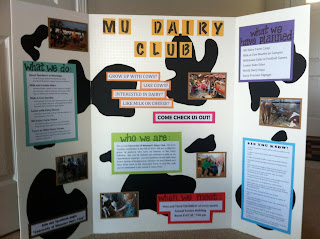The summer months are here, and with that comes heat-related challenges on the dairy farm.
The ideal temperature for your average Holstein is about 70 degrees. Usually, cows can catch a break from the heat at night and be fine, but the humidity will persist. Therefore, it's the humidity that causes the big problems.
Like people, it requires energy for a cow to deal with being in the heat and humidity. They don't sweat, so they pant (like dogs) to cool off. When a cow is using energy to keep cool, that's energy that isn't being used for milk. When the heat and humidity rise in the summer, producers will quickly see milk production decline. So, it's in the best interest of both cow and farmer to do whatever it takes to "beat the heat."
 |
| cows under misters |
At our farm, there are lots of measures taken to keep the cows comfortable, and since my internship, I've seen a variety of methods. Our farm utilizes fans and misters, positioned in the ceiling of barn. Every few minutes, a fine spray of water will mist over the cows, soaking their backs, with the fans on constantly. This has an evaporative cooling effect, which is a quick and efficient way to cool off the cows. It also seems to be the most popular.
The grazing farms I visited have utilized the natural shade from the tree lines out in their pastures. I also saw another grazer who left the entrance to his milking parlor accessible for the cows, so they can walk up there at their leisure and stand under the misters.
Down in Oklahoma, cooling ponds were really popular. Farmers would dig out a pond, usually with a solid base at the bottom, and a gradual slant on the sides. This way, cows could easily walk into a pond and cool off whenever they wanted to. Most of these ponds are refilled regularly so the water doesn't get too dirty and become a hygiene problem for the cows.
The most important factor is obviously water. I've never seen a farm where there wasn't unlimited water available for the cows. Even under perfect weather, cows drink a lot of water- because the milk they are producing is 87% water. Also because of this, their milk production affects how much milk they drink, but the average cow drinks 25-60 gallons a day. During the summer, their water requirement is even higher, especially considering how much is lost in milk production. Most farms have multiple automatic waterers available to the cows at all times.
I'm a cold weather person, so once it hits about 85 you're probably gonna hear me gripe. But I gripe a lot less now that I see that the farm doesn't stop just because it's hot. Farmers and cows work the same, if not more, in this heat and I have a great deal of respect for them because of that. In fact, I think they should be on a Gatorade commercial.
photo: http://raylindairy.wordpress.com/2011/06/15/cows-play-in-sprinklers-wordless-wednesday/










